From soft shell, to tortoise shell pyramiding and shell rot. Our guest author explains the problems tortoise owners can experience with their tortoise’s shells. And how to prevent them.
Is your tortoise insured? Get a quote for £2,500 of vet fees, death and theft cover. Vet fee cover only also available | We’ve been insuring exotic pets since 1996 | Check out our customer reviews on Feefo.
The tortoise skeleton
The shell of a tortoise is made up of two distinct layers. There is an inner bony layer, which encases and protects the body and vital organs. This is comprised of some 50 bones which are linked together to create the underlying shape of the shell.
On top of this is a covering of keratin, which is the same material that makes up our fingernails. This is laid down in a distinctive pattern, with the individual segments of the shell known as scutes.
The joins between the scutes are different to those in the underlying bony area, serving to reinforce the overall strength of the shell as a result, in the same way that when building a brick wall, the joins do not overlap in successive layers.
The outer coloured keratin layer of the shell has blood vessels and nerve endings, meaning that it can bleed and any injuries here may be painful.
Tortoise shell pyramiding
Pyramiding affects the scutes on the top part of the tortoise’s shell, known as the carapace, causing them to grow abnormally, often in a shape rather like that of a mini-pyramid which explains the name of this condition.
The vertebral scutes running down the centre of the shell are most likely to show signs of pyramiding, but the costals which lie on either side above the ribs can also be affected.
The signs can vary from mild to very disfiguring, affecting the tortoise’s mobility and its ability to mate successfully in extreme cases.
Pyramiding can be seen in wild tortoises on occasions, but it tends to be more prevalent and extreme in young tortoises, being associated in particular with certain species.
Those most likely to be affected include red-footed tortoises (Chelonoidis carbonarius), sulcatas (Centrochelys sulcata), Hermann’s tortoises (Testudo hermanni) and both star (Geochelone elegans) and leopard (Stigmochelys pardalis) tortoises. However, it is not seen in hingebacks (Kinixys species).
Causes of shell pyramiding in tortoises
There is no single clear cut cause of the condition. It can be linked with both the the humidity of the tortoise’s enclosure and with its food. Young, faster-growing tortoises are most at risk.
-
- Enclosure humidity: Young tortoises housed indoors rarely have the opportunity for their shells to get wet, spending their time indoors, typically with a heat lamp above, and so they are kept in a very dry atmosphere.
The situation for red foots in particular is very different in the wild, where they are to be found in areas of tropical forest.
Investigative studies in the USA were carried out into young red footed tortoise that were housed and fed under near identical conditions.
One group had damp paper toweling in their retreat, while the other was housed with dry paper. It was this latter group that displayed pyramiding.
- Enclosure humidity: Young tortoises housed indoors rarely have the opportunity for their shells to get wet, spending their time indoors, typically with a heat lamp above, and so they are kept in a very dry atmosphere.
- Diet: High protein diets, based around items such as dog or cat food, are particularly dangerous and should never be provided.
The amount of food consumed is another factor. In the wild, tortoises such as sulcatas that originate from arid areas tend to stop eating during the dry season when food is in short supply, and so their growth ceases, whereas captive bred sulcatas tend to be offered food constantly, on an ad lib basis.
The resulting abnormally high growth rate causes the cartilage around the bone to collapse and ossify, hardening the bone in this abnormal position. This raises the keratin layer above it, creating the distinctive signs of pyramiding.
There is no cure for shell pyramiding and the signs are more likely to emerge in young tortoises.
How to stop pyramiding in tortoises
The condition is not well understood, although it appears that both dietary and environmental factors are responsible.
Therefore the emphasis needs to be on prevention. Ensure your Ensure your tortoise receives a species appropriate diet, noting that red foots for example require more fruit, compared with most other species that eat herbage.
Do provide a provide a damper area where your tortoise can retreat if it wishes. Bathing may help too as another preventive measure.
If you are concerned that your tortoise is starting to show signs of pyramiding, then seek the advice of a specialist reptile vet.
Running through your management and identifying any problems at this early stage is the best way to combat this disfiguring condition.
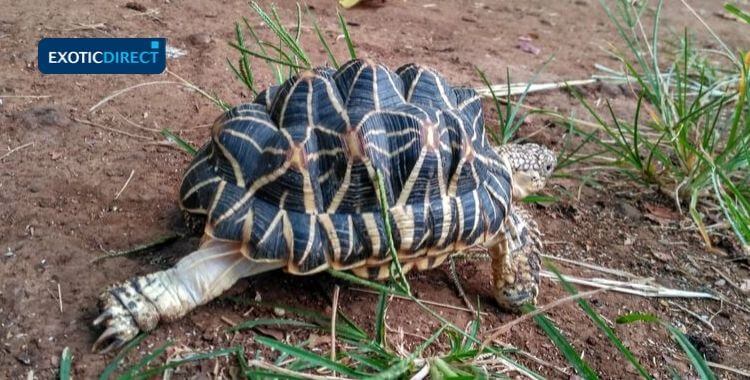 Shell pyramiding in an Indian Star tortoise
Shell pyramiding in an Indian Star tortoise
Soft shell in tortoises
Tortoises need exposure to UV to help prevent developing a soft shell
Known scientifically as metabolic bone disease (MBD), this condition is caused by your tortoise receiving an inadequate supply of calcium, or an imbalance in the calcium:phosphorus ratio.
A deficiency of vitamin D3 can also be a cause of soft shell, because it stimulates the uptake of calcium from the gut as well as controlling its use and storage in the body.
Aside from being the main component of the skeletal system, calcium has other important roles, in terms of nerve-muscle co-ordination and as the major component of the eggshell too.
Symptoms of metabolic bone disease
- A soft, misshapen shell, although it is important to remember that the shells of young growing tortoises are not as robust as those of adults.
- A reluctance to move, which can be combined with an overall lack of co-ordination.
- Unexpected limb fractures.
- An increased risk of egg-binding in female tortoises, because of the presence of soft shelled eggs.
Did you know?
The pancake tortoise (Malacochersus tornieri) is unique in having a shell that is naturally flat and soft, having sacrificed this protection for speed and mobility.
Is your tortoise insured? Get a quote for £2,500 of vet fees, death and theft cover. Vet fee cover only also available | We’ve been insuring exotic pets since 1996 | Check out our customer reviews on Feefo.
Tortoise soft shell treatment
The first step is to determine the cause of the deficiency. Be familiar with the calcium levels in the food that you are offering your tortoise. Dandelions in particular are rich in this vital mineral.
Use one of the vitamin and mineral supplements available for reptiles, in accordance with the manufacturer’s instructions.
The risk of MBD is lessened if you use a pelleted diet alongside fresh foods for your tortoise, as these are carefully formulated with regards to their calcium:phosphorus ratio.
The critical ultraviolet B (UVB) wavelengths of light which are necessary to produce vitamin D3 naturally in the tortoise’s body will not pass through ordinary glass, and you need to use a special reptile lamp for this purpose, which emits UVB.
Young tortoises, such as Hermann’s and Horsfield’s (Agrionemys horsfieldii) which are being reared indoors are especially susceptible to MBD because they will be growing relatively fast, and therefore have a higher dietary calcium requirement to support their growth, compared with non-breeding adults.
Provide broken cuttlefish bone, as more commonly sold for pet birds, since this can be another source of calcium for tortoises. They nibble pieces off the softer, powdery part, particularly in the case of females when they are approaching egg-laying.
Particular care needs to be taken with female sulcatas, because of the relatively large clutches of eggs that they produce. As a consequence, any calcium deficiency is then more likely to become apparent.
Did you know?
Always be sure to follow the manufacturer’s instructions about when to replace the light, because although it will not be evident to our eyes, the ultraviolet output will decline over time, and so it must be changed typically after 10-12 months.
Prevention of Metabolic Bone Disease
The only definite way that it is possible to determine that your tortoise’s calcium levels are healthy is if your vet takes blood samples, although X-rays revealing the tortoise’s bone density can also give a valuable insight.
Prevention of MBD is much more straightforward than cure, and provided that you offer your offer your tortoise a good diet, and ensure that its environmental needs are met, then this condition should not be a cause for concern.
If you suspect that your tortoise could be affected though, then as always, the sooner that you seek veterinary confirmation, the quicker that your pet is likely to recover, once it has appropriate treatment. In general, the beneficial impact of treatment become apparent quite rapidly.
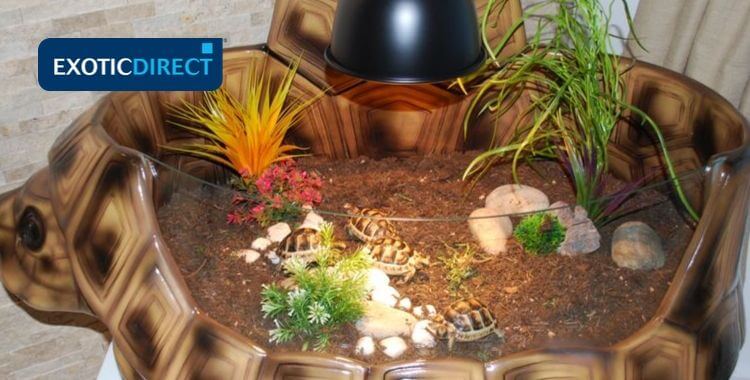 UV exposure helps prevent soft shell developing in tortoises
UV exposure helps prevent soft shell developing in tortoises
Tortoise shell injuries
Always pick your tortoise up carefully, because if it struggles and kicks back with its hind legs, you may end up dropping it.
If your tortoise falls head first, it may escape any head injury by pulling its head back into its shell. However, it could easily chip the edge of the shell instead, resulting in bleeding.
Animal attacks
The body casing of a tortoise’s shell does offer some protection for the internal organs against injury, but it is not certainly guaranteed to protect against serious pressure being applied.
Injuries resulting from the bites of foxes and indeed pet dogs can afflict tortoises roaming freely in gardens.
Damage of this type can be serious if not fatal, even if the bite marks are relatively inconspicuous. This is because the animal’s teeth effectively inject harmful bacteria deep into the reptile’s body.
Veterinary advice is essential with this type of injury, and treatment is likely to involve thorough cleaning of the wound site, painkillers and antibiotic treatment.
Crush injuries
Injuries of this type are also likely to affect the shell. The causes can vary from being run over by a vehicle through to having heavy objects such as a stack of wood falling down on top of the tortoise.
The shell damage in such cases may not always be evident though, depending partly on the cause, and so imaging techniques are likely to be required, to determine what is happening within the tortoise’s body.
Radiographs may give a helpful insight, although CT (computerised tomography) scanning often provides a clearer indication, dividing the body up into sections. In either case, because tortoises are placid, so they are unlikely to need sedation under these circumstances.
Shell repairs
If the shell itself is badly damaged, then treatment and bridging of the underlying bony layer will be required, and this is where the experience of a specialist reptile vet can be crucial.
The first critical step is to prevent any risk of infection arising from the injury, and then look to assist the healing process by repairing the damage. This may be achieved in a variety of ways, on a case-by-case basis. It may include fitting the bony areas back together as far as possible and wiring parts together.
The area of damage is usually covered with a combination of epoxy-resin fibreglass cloth, mixed with epoxy resin that will not be harmful to your pet either. This protective cast may need replacing, especially in young tortoises as they grow.
Shell repair is a slow process, and this body casing may be required for two years or so, with regular veterinary check-ups required to monitor your pet’s progress throughout this period.
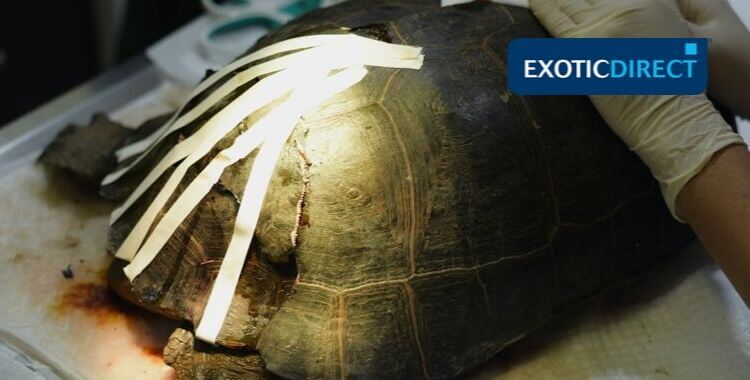 Treatment for a severe shell injury in a sulcuta tortoise
Treatment for a severe shell injury in a sulcuta tortoise
Tortoise shell rot (ulcerative shell disease)
Garden tortoises, especially Horsfield’s that dig themselves into wet ground, and other burrowing species are potentially more vulnerable to infections of the shell.
Any changes in the appearance of the shell, or lifting of the scutes can indicate this type of problem. Never be tempted pull off a raised scute, as this could worsen the problem.
Watch for signs of pitting, as reflected by holes forming in the shell, especially on the underside of the shell (which is known as the plastron).
This is typically an indication that environmental conditions may be dirty and possibly too damp, facilitating a build-up in bacterial numbers. It can be a problem in red-footed tortoises for example.
Should an area of your tortoise’s shell start to develop any whitish patches or becomes abnormally discoloured, this is a further indication of an infection. This may have arisen following a relatively minor injury.
As ever, seek veterinary advice as soon as possible, so appropriate treatment can be given quickly. The most appropriate course of action depends on the location and extent of the problem.
Antibiotic treatment is required in cases of the so-called ‘wet form’ of this disease, which usually result from a bacterial infection of the Gram negative type.
“Dry cases” are typically the result of a fungal infection, and require anti-fungal therapy. Removal of the affected parts of the shell may also be necessary, to treat the condition effectively, allowing the ulceration to heal.
Septicaemic Cutaneous Ulcerative Diseases
There is a specific form of shell rot, known as Septicaemic Ulcerative Shell Disease or SCUD. Signs to watch for:
- Pitting to the shell.
- Red spots, which are haemorrhages, present both on the shell and the body too
- The tortoise is very lethargic
- It also has no interest in food
SCUD occurs when the harmful microbes responsible for shell rot gain access and start multiplying more widely in the body, being carried in the blood stream and attacking key organs like the liver. Urgent veterinary help must be sought if the tortoise is to have any hope of living once a shell infection progresses to this state.
David Alderton is our guest writer. As well as a reptile expert he’s also the editor of Practical Reptile Keeping and a published author.

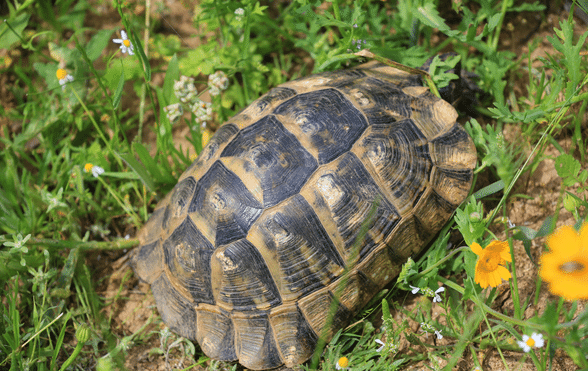
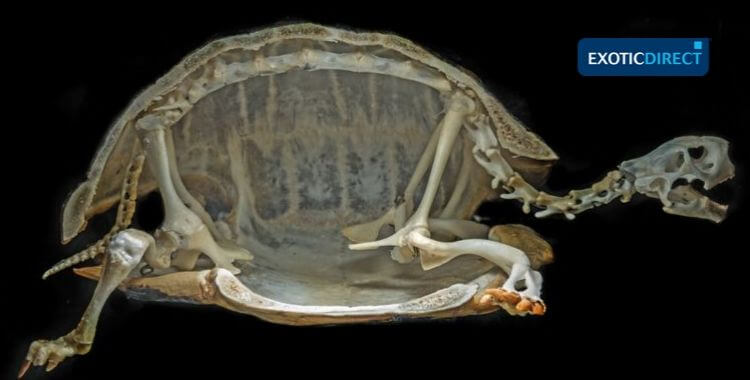 The tortoise skeleton
The tortoise skeleton